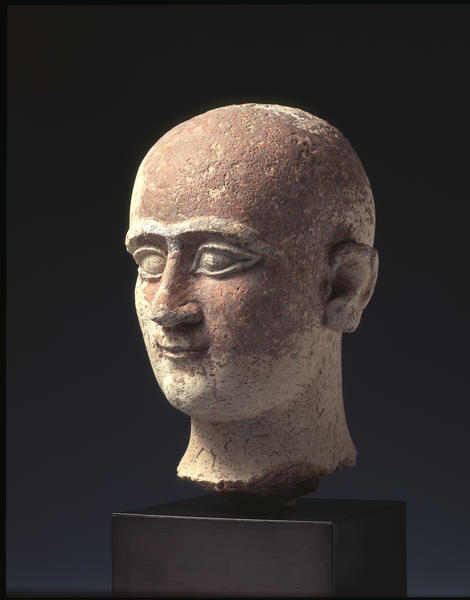礼拝者頭部
- メソポタミア ウル第三王朝~イシン-ラルサ時代
- 前三千年紀末期~前二千年紀初期
- テラコッタ
- 所蔵
- 個人蔵
シュメールの神殿は誰にでも開かれていたわけではなかった。初期王朝時代に礼拝者像が発達したのはこのためである。神像の祀られている至聖所の中に礼拝者の身代わりとして石灰岩、石膏、テラコッタなどの彫像が神に捧げられたが、通常それらの両手は腰の高さで前に組まれている。これは祈り、すなわち神への語りかけの姿勢であった。このような像を奉納することにより、奉納者はそこに居なくてもその魂は永遠に神の御前にあったのである。神に語りかける彼らの表情は時に生真面目であり、時に最高のほほえみを示している。イラク、テル・アシュマーの出土例からは、この種の像は奉納者の死などをきっかけとして、神殿の床下などに埋められたことが窺える。
この若い男性の頭部は神官像か奉納の礼拝者像であったと思われる。長円形の頭部にあごの窪みを作り出し、耳は極めて写実的な造形を示している。繊細に形成した口元はその両端がやや上にあげられ明確にほほえみの表情を示している。
Catalogue Entry
The temples of Sumer were not openly accessible to all, and this exclusiveness contributed to the development of worshipper-figure sculpture during the Early Dynastic period. It became customary for those who wished to worship at a temple to have figures of themselves, sculpted in limestone, gypsum, terracotta, and so on, placed in the temple’s inner sanctum where the image of the deity was enshrined. In most cases the figure’s hands are joined in front at about waist height in a pose of praying to or addressing the deity. By dedicating such statuettes to a temple, worshippers indicated that in spirit they were constantly and eternally worshipping before the god, even when physically elsewhere. While some of the praying figures have very serious facial expressions, others wear charming smiles. From examples unearthed at Tell Asmar in Iraq, it is surmised that at the deaths of the worshippers portrayed or on other significant occasions figures of this type were buried under temple floors and elsewhere.
The worshipper figure shown as cat. no. 001 was dedicated to a temple. Like many Sumerian figures, this one is depicted wearing a sheepskin garment and has inlaid eyebrows that meet in the middle of the forehead. The eyebrow inlay and eyeballs have been lost, though it is surmised that the whites of the eyes were rendered with shell and the pupils with lapis lazuli. The expression of the mouth is unmistakably a smile.
The figure of a female worshipper at cat. no. 002 has also lost the inlay of its eyebrows although that of the eyes remains. This figure’s hairstyle and left shoulder-covering garment are similar to those of a female figure excavated from the Inanna temple in Nippur. Her tear-drop-shaped eyes and the well-defined features of her face from cheek to chin show an animated smile as well as an arrestingly lifelike quality.
The sculpture of a young man’s head at cat. no. 003 is thought to depict a priest or temple worshipper. The oval head features a dimpled chin and very realistically formed ears. The delicately modeled mouth area clearly shows a smiling expression, with both ends of the mouth curling slightly upward.

